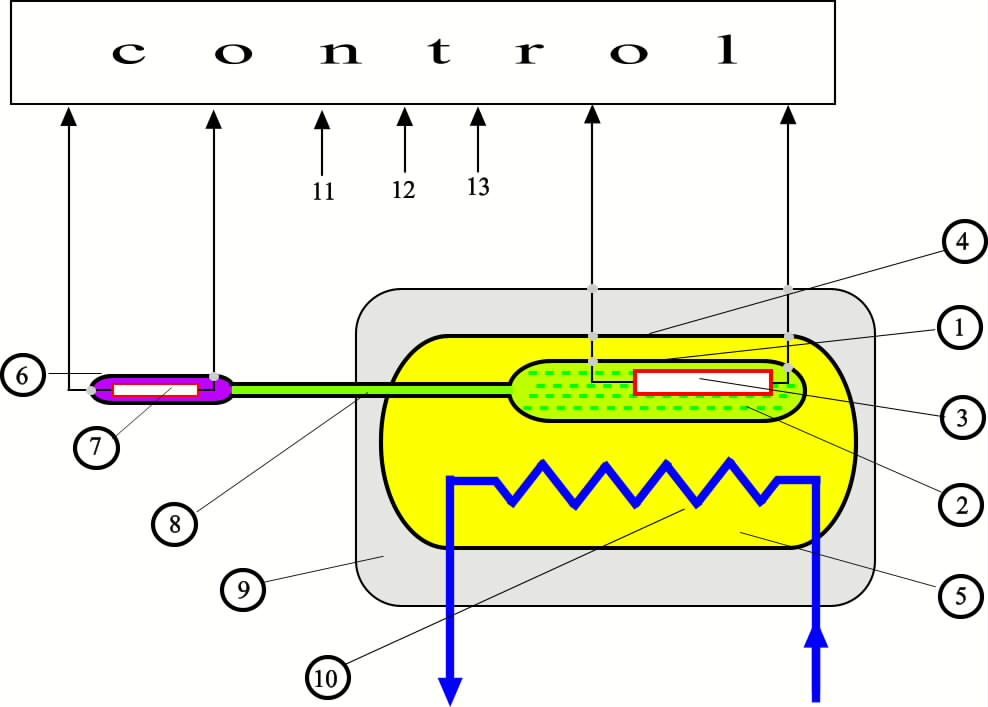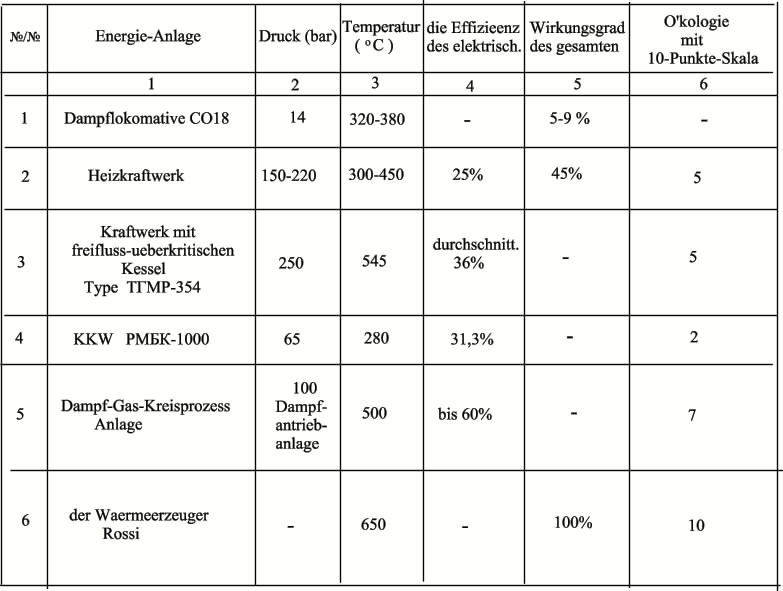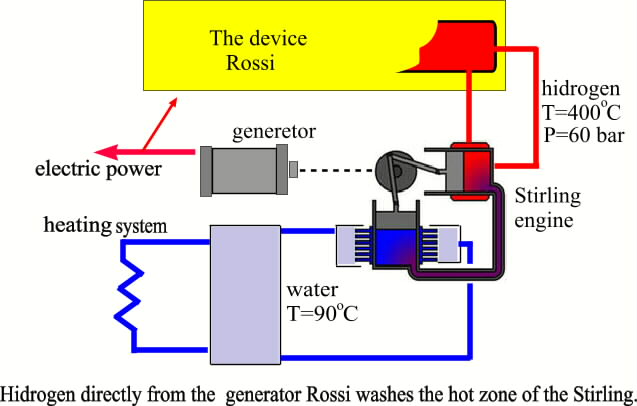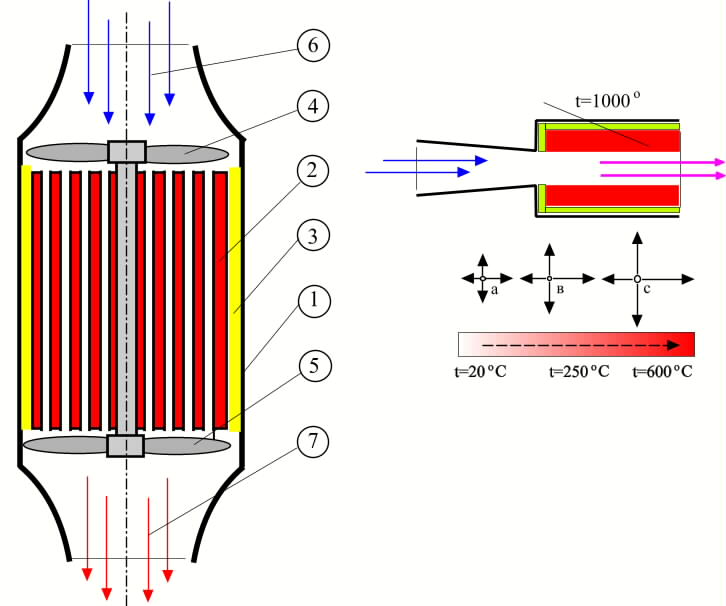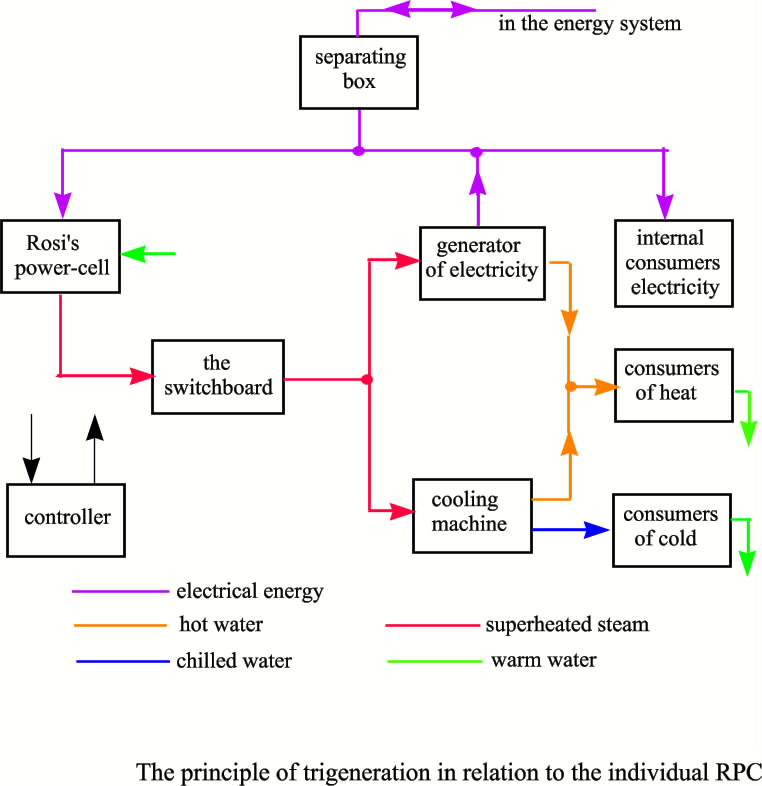|
|
|
|
|
|
|
|
Sorry
for the poor quality translation. source here
Rossi's
power-cell. (RPC ���)
By early 2012, the
structure of the RPC gradually took their full functional form, as a kind of
unit, suitable for a wide application in many sectors of the economy. Rossi
proved the reality of LENR energy on an industrial scale to produce, and now it
is time for the intellectual, operational and financial resources of the Society
for the widespread use of this opportunity to connect. Suddenly a broad front
of the work appeared in four areas: academic science, experimental physics,
engineering applications, speculative commercial direction.
|
The picture shows a
generalized diagram of the heat generator Rossi, a configuration with a series
of necessary and sufficient components for the operation of the device. |
fig. 1. |
Such conditions are
hydrides of some metals just like Magnesium hydride. One cubic centimeter of
this powder contains hydrogen by weight and a half times more than its
contained the same amount of liquid hydrogen. However hydride of iron-titanium
alloy such as dissociated at temperatures from 320 to 370 K with a low heat of
formation. The tube (8) connects the regenerator of hydrogen with a closed
reactor of thermal insulation (9). The selection of heat takes place through
the heat exchanger (10) from where there is the coolant in the form of water or
superheated steam. Device control and management receives information from the
temperature and pressure sensors. It maintains the heat of the reactor at the
desired level by controlling the temperature of the regenerator of hydrogen.
The principle of operation.
The scientists in the chemical catalysis, and employs a lot of detail
with the nickel-hydrogen system. They are well known, with processes at the
interface between solid and gaseous phases, such as:
- Dissociative chemisorption of hydrogen molecules on
metal surfaces,
- Dissociation of the adsorbed hydrogen atoms into protons
and electrons,
- Proton dissolution of atomic hydrogen in the crystal
lattice of nickel with the transition of an electron in the conduction band of
hydrogen in the metal.
Written many articles on this topic, for example here or here.
The question is why
the researchers did not notice the anomalous heat generation in their working
patterns? Maybe because they deal with two-dimensional structures, more
sophisticated, but the surfaces. And no one before and Rossi Piantelli not
kalorimetriert the nickel nanopowders under considerable pressure at a high
temperature in a hydrogen atmosphere. Here is just nanopowders, apparently, is
the key. The large surface section between the two phases has led to a
transition from quantity to quality - the start of the heat released
commercially. It turned out that the hydrogen that diffuses through the nickel
grid of dismissal of an electron, has a non-zero probability to penetrate the
core of an atom of nickel. In implementing this probability is LENR - reaction,
accompanied by a large release of energy. Modern science has to deny recently
accompanied the possibility of LENR processes by transmutation of energy
release, and not able to explain clearly the physical nature of the phenomenon.
(Here), but this fact should not prevent the introduction a new efficient heat
source, and the ambiguity of the combustion process does not interfere with
people thousands of years, the use of pyres.
Thus, the more hydrogen
atoms is in the lattice of nickel, realizes the more the probability of
absorption of the proton nucleus of nickel. The concentration of hydrogen
protons in the crystal lattice of the larger, the higher the temperature in the
reactor, the higher the hydrogen pressure, and the more developed the interface
between the gas and the metal crystals. The easiest way to manage the reactor
change, the gas pressure. What has been implemented by introducing in the
device node of the regenerator of hydrogen. It should be emphasized that the
emergency situation that can not be to "accelerate" the process of
heat in the reactor warden occur: during the heating of the specimen sintering
or melting will occur the nanopowder, which leads to a decrease in the
concentration of protons in the crystals .
Operational
quality.
Rossi
generator designed to generate heat energy, it runs on the controller and
allows you to implement custom schedule of heat. The device is connected to the
network, which in operation continuously uses a small amount of electricity to
power the controller and the heating element (7) of the regenerator. Greater
consumption of electricity is required for the initial start-up device. In this
case additionally works fairly strong the heater (3) of the reactor. He
predestined to heat the entire volume of the reactor to operating temperature
and warming to hold until creates diffusing into the nickel crystals hydrogen,
a proton concentration in order to initiate the exothermic reaction. It is
noteworthy that shown for the two-circuit heat transfer, as in the figure, the
power consumption of starting-up phase is substantially less than for
single-circuit, since the heat is not flushing away through the coolant, while
the reactor heated.
Thus, the specific
nature of the heat source at the generator Rossi a slow start after the break,
a relatively shallow level of power control and the slow change of the current
value of the thermal power released. However, these drawbacks are insignificant
in comparison with such dignity, such as an extremely low cost of energy
produced.
Place of RPC
on energy sources.
Generator Rossi, of
course, can be used for space heating as a local heat source, but much better
to treat it as a tool for collaborative production of electricity and heat (the
principle of Cogeneration). In this respect interesting to compare it to other
heat sources that are used to generate electricity. Currently, the most
important technical tool for converting thermal energy into electricity by a
turbine-generator efficiency and the turbine generator and other steam engine
depends mainly on the parameters of the steam at the inlet of the turbine.
|
The following table
can be compared, is the area in which these parameters with the use of thermal
energy in the various technical systems. The same data are in the graph of the
phase diagram of water shown. Some clarifications on the points table. A significant
proportion of the electricity in the world produce thermal power plants.
Despite the fact that the steam parameters have come far in the supercritical
region of the phase diagram of water and the formula for the Carnot promises
good efficiency (paragraph 3 - **), the average efficiency of the Russian power
plant would be about 36%. This is due to the fact that all the heat of
vaporization (2260 kJ / kg), which is released into the condenser, it is
necessary, in cooling towers or cooling pools to be dissipated. In Russia, the
practice of building district heating plant (** item 2) was developed. Due to
some reduction in efficiency, it managed to increase the water temperature from
the external circuit to a level (120 - 140 degrees). This made it possible to
transfer the hot water over long distances for the heating of the surrounding
residential areas. |
fig. 2. |
|
In the West, went the
other direction. Steam-gas cycle process (Item 5 - **) separates thermal energy
that is released when fuel utilization in two parts - a gas turbine and steam
turbine. The result was a phenomenal increase in the efficiency of the unit,
almost doubled (from 36 to 60%). This is explained by the fact that a wasteful
process of heat transfer through a two-phase heat transfer medium (water) used
only in the last stage of the process. In other words, the amount of evaporated
water per kilogram of burned fuel in a steam-gas process is about three times
smaller. Against this
background, looks extremely pale, the parameters of the coolant in nuclear
power plants (Item 4 - **) - the most common reactor type RBMK-1000. Water -
water two-circuit system, and the need for frequent replacement of the fuel
rods in the work unit, which are connected to the technological penetration
into the volume of the primary circuit, led (bar 65) to lower operating pressure
and temperature (280 degrees.). Reproduced in the official 31.3% efficiency is
not always fully taken into account energy expended on the station's own needs.
The use of "junk" heat for the plant is not possible, because of its
remote location. The heat generator Rossi (item 6 - **) allows the coolant to
650 degrees. C heat, while the pressure and only to the strength and heat
resistance of the heat exchanger. |
fig. 3. |
Generally in the
energy sector, despite the fact that cleaner burning fuel in a closed space in
the position of the heating boiler design to very high temperatures, can not
penetrate far into the supercritical range of the phase diagram of water. About
Critical fluid acquires new properties, in particular, it is chemically
aggressive. For example, in Iceland, to extract the geothermal energy in the
volcanic area, drilled deep into more than two miles. The resulting fluid
having a temperature of 1100 degrees C corroded pipes and heat exchanger made
of stainless steel. In the column of Table 6.5 of the overall efficiency of RPC
was set to 100%. This is due to the fact that the local device on the principle
of combined heat and power (CHP - Cogeneration), that operates heat, which is
not used to generate electricity, used for heating or air conditioning.
With all favorable
settings of the thermal generator Rossi laurels of victory between the energy
sources is still part of the solar and wind energy - it does not cause thermal
pollution.
The type
of heat-elimination device
Apart
from the auxiliary details, you can look at the heat source Rossi as fuel
element. It is characterized by a well-defined density of volumetric power
output (W / cm ³), geometric shape, which determines the transport of heat from
the working volume and surface area through which heat causes in the
refrigerator. The closest analogue to the physical device is considered a fuel
rod that works on all types of nuclear reactors. It is useful to compare these
two devices.
The
volumetric energy release. Fuel rod in the form of a long tube with a
diameter 1.9 mm is -13.5 bar in the flow of the cooling water with the
parameters of 65, disposed 280 degrees C (for RBMK-1000). Data for its energy
performance are well known: volume up to 450 W / cm, linear 17 kW per meter of
pipe and heat flux 0.6 MW per square meter of surface heat transfer. While no
detailed data for RPC, from the statement that the internal medium of the unit
(molten salt) can can exceed 650 degrees C (here), we conclude that the energy
level of RPC same magnitude as the fuel rod has. "... Has successfully
completed its PDGT scientific, technological and engineering Necessary steps to
sustain such a reaction with results Exceeding a COP of 20 and with
temperatures exceed 650 degrees Celsius capable to ..."
The
energy source. The fuel element of the reactor, the forced splitting
of uranium 235 takes place in the force field of thermal neutrons. The process
has the statistical and cascade-condition, the average energy of 202.5 MeV for
the decay of a nucleus. The RPC is the cold fusion reaction of hydrogen with
one proton nucleus of an atom of nickel (LENR process) assume will be achieved
by, releasing energy that accompanies the nuclear scale. One mole of nickel
makes about 23 000 kWh of thermal energy.
The temperature
distribution in the structure. Fuel element operates in a very tight operation. The
tablets of uranium dioxide have low thermal conductivity, there is a
significant temperature gradient in the radial direction: 1600 - 1900 °. C on
the axis of the tube, on the surface of the tablet, respectively, 470 -900
degrees, further, difference between the pills and the cladding, the falling on
the pan 20 degrees, and finally, 350 degrees. on the surface of the element. To
increase the thermal conductivity of the fuel element, is pumped into the tube
helium, the pressure in operation is up to 80 bar to 100. In operating pressure
can be more enhanced in consequence of the accumulation of gaseous
decomposition products. Solid products of nuclear reactions (heavy uranium atom
splits into two lighter) apart span the tube of the fuel element so that it is
unsuitable for further use, long before the complete combustion of the fuel.
Sun Defcalion GT features to its site, the 21-page specification
Hyperion their
developments. The reactor core - a cylinder with a diameter of 4 cm and 10 cm
long, with a volume of about 125 cubic centimeters. Loose nickel powder in a
hydrogen atmosphere at elevated pressure. With high throughput, and the thermal
conductivity, hydrogen can successfully the heat to the inner surface of the
structure transmitted without areas of local overheating.
The
shape of the energy excretion. The decay of uranium-235 nucleus
into two unequal parts occurs in the seizure of the nucleus of a neutron. The
method is probabilistic in nature. In the fission products are up to 300 other
unstable isotopes of different substances, from Z = 30 (zinc) to Z = 64
(gadolinium) is to excite the cascade of further nuclear reactions take the
tails of these decays may years. Hundreds of types of nuclear reactions are
accompanied by all kinds of radiation with very different energies. In the RPC,
the processes are more monosyllabic - produced only two or three stable
isotopes, energy is in the form of soft X-rays (less than 150 keV) are released
and transferred directly to the nickel lattice.
Managing
the process. Uranium 235, one of the few elements that can sustain
a chain reaction of nuclear fission. Fuel can only work in an environment of a
nuclear reactor. He needs a force field of thermal neutrons, produced jointly
by all the modules, regulator and balance rods and other parts of the reactor
design. Uranium-235 responds to the need on the threshold level of criticality
for 10 ^ -3 seconds (time constant) and for the stable operation of the reactor
that all coefficient of reactivity were negative. For RPC specific heat is
determined by the concentration of hydrogen protons in the nickel lattice. Time
constant of the process is determined by the rate of diffusion of hydrogen in
the solid phase, ie, not milliseconds, both for the fuel, but minutes and tens
of minutes. From here, manageability, and reliability of the device by Rossi.
The
scalability and applicability. A fuel assembly is designed to
work in the construction of a nuclear reactor, an isolated operation of this
device is not in question. For RPC is present tube design is not the limit
seems possible film structures and a massive volume with channels for the
cooling liquid. Accordingly, and the wide field of applications - from cell
phones to large turbines.
Ecology. Used nuclear fuel,
due to the residual long-lived radioactive isotopes decay processes, must be
isolated for many months in the pool, and suspend and during the subsequent dry
storage of active ventilation. It is cheaper to bury this stuff in the rocks of
the alluvial fan in the Arctic Ocean at the mouth of the Mackenzie River. RPC
at the minimum protection does not radiate, does not accumulate unstable
isotopes are fully recycled and regenerated in a simple chemical process.
Place in
the middle of LENR processes.
There are some
spectacular effects, such phenomena Schoulders, Vachaeva, Adamenko, Ushirenko
which accompany the transmutation of elements, intense energy release and the
involvement of charge-cluster phenomena. However, unexpectedly moved forward,
the process of nuclear interaction on the resonance frequency of the hydrogen
protons in the crystal lattice of nickel.
Yes, based on the effect of Fleischmann-Pons' an installation by Andrea Rossi
proved to be more logical techno to get the heat on an industrial scale. But,
of course, that after removing the tacit LENR-taboo around the world unfolds
and opens itself to finance a broad front of work. And then developments KEN
'SHOULDERS', its charge-clusters, researchers will lead to the possibility of
direct conversion of nuclear energy into electricity. (Here) on his Vachaev
"Energonive" probably many kilowatts of electricity gets turned off
successfully, and radionuclides. (here) to the promise of Adamenko developments
in his laboratory (proton 21) to obtain the industrial extra heavy stable
elements. (here) In general, any transmutation of matter transforming nuclei of
one element into another, with different composition of the nucleon, and appear
at the same deficiency or excess charges, can, of course, is to be converted
into an electric current, you only need a to find suitable way.
Only four metals in
nature - iron, nickel, palladium and platinum have the ability to dissociation
of adsorbed hydrogen into protons and electrons following proton penetration
into the crystal lattice. The effect of Fleischmann-Pons' and open to the
palladium and implemented on an industrial scale on nickel are not excluded
from consideration as a promising source of boundless energy and also iron.
The
specific implementation of the system.
The first trades, the
inventor A. Rossi can be presented at the shows instead of the existing
laboratory models are estimated, - installation of experimental physicists are
always structurally redundant, depending on short-term opportunities and local
artists. Nevertheless, they held a demonstration to investors to convince them
to invest heavily in design, engineering products. (In particular, Decalion
Green Technologies released a series of devices, "Hyperion" hier. ()
only significance to the assembly are "megawatt, he" returned from
the small blocks - having Rossi, not enough time, instinctively clings to the
found earlier decision.
Once falling into the
hands of professionals in the technology, the idea of guarding the missing
components, such as how regenerator of hydrogen, instead of the difficult and
dangerous to the operation of the hydrogen balloon. Similarly, will be
assessed, such illogical practice, how much of the heat that is used for
formatting the preparation transferred directly to the consumer. Next, more
efficient units will not be recruited from smaller structural units. And of course
the first thing that user to the RPC system, a device for generating
electricity.
|
As an unknown still
quite efficient method for the direct conversion of nuclear energy into
electrical energy, and Rossi generator is a heat source, power obtained with a
more or less acceptable efficiency is possible only via an intermediate
transfer of heat energy into mechanical energy. Such a transformation takes
place during the expansion of the hot gas (pressure medium) in a particular
structure that the ability to change its internal volume must, for example in a
cylinder or a turbine. As a
working fluid (working mass) can emerge: 1. First The same hydrogen that participates in
the LENR process of the generator Rossi. 2. Second Air or another gas, heated by contact
with hot designs RPC. 3. Third The liquid is vaporized and superheated
in the heat exchanger, which is in thermal contact with the construction of the
reactor (of water vapor other liquids). |
fig. 4. |
|
In accordance with
the principle of Carnot efficiency of this transformation is larger the higher
the temperature difference between the working fluid at the beginning and end
of the process. On the first point, this difference is the greatest, example of
this principle are shown using the Stirling engine in Figure 3. The second point is
illustrated in Figure 4. The principle of Staustrahldüse and the ramjet could
be fully extended to the heat source Rossi. The air is warmed up along the
heated surface, expands, pressure and axial velocity component increases. As it
happens, the plan says the right. During the heating of the gas linear
velocities of the molecules is proportional to grow in all directions. (Vector
diagrams a, b, c) molecules, which move to the left, meet in the cooler layers
of gas, stuck in them. They give their energy to the heating of these portions
of the gas. Compensate in this case the vertical offset vectors, and preferably
the right direction. |
fig. 5. |
And this is the main
disadvantage inherent in the method using a two-phase refrigerant. In the
mechanical work into electrical energy, and therefore only the thermal energy
will be transferred, stored in the superheated steam, but provide a significant
heat of vaporization must be completely in the refrigerator. In the case of
water, its temperature is at the outlet of the condenser cooling circuit is not
more than 50 - to provide 30 degree - 60 degree, and the input capacitor must
not hot water 20th This relationship makes little interest to utilize waste
heat for heating purposes, and provided nearly impossible for air conditioning.
This can be by the fluids to help with higher boiling points, but it decreases
the efficiency of power generation.
If RPC is used
without a power generator, only a heat source, then it would be nice if the
device does not provide start-up, or at least operating system power supply. Such
possibilities are, for example, is currently in bismuth - produced telluric
thermoelectric module (HZ-20 Thermoelectric Module
http://www.hi-z.com/hz20.php), with dimensions of 75 * 75 * 5 mm in temperature
difference of 200 degrees produces 20 watts of electricity with an efficiency
of 4.5%.
Heating
and air conditioning.
A. Parshev in his
essay "Why Russia is not America" is wrong, "that our country is
not competitive due to the harsh climate in its territory who spent too many
resources on capital construction and heat for heating buildings. Much more
people around the world suffer from the heat, - the need for greater cold, cold
production expensive - the need for refrigeration is wider, cold production is
more expensive would, even in our northern border of the 3-4 months of the year
does not hurt to air. -conditioners operate, however, food refrigerator in
Russian families "eats" a third to half of the current. Three billion
of "Southerners" could be very substantial increase in energy
consumption, they would have to "human" in terms of temperature and
humidity in the home and in the workplace.
Realized with current
in sufficient quantities, no problems with heating, air conditioning, it is
also easy for a 1000 kW cooling capacity with modern vapor-compression machines
(cooling coefficient I = 3,0) have to spend about 300 kW power. The cold
therebetween can be obtained with a heat source - it is widely used by
absorption chillers. They have not so large cooling rate (I = 1.35), and the
cold water temperature at the output of 2 to 5 degrees. C, but they are
environmentally friendly, no noise, reliable and consume almost no costly power.
Individual user weight is calculated on the RPC needs, usually at the same time
and heat and cold, and electricity. The relationship between the carrier of
energy during the day and can vary depending on the season. To produce the
complex heating, cooling and electricity - is brought into modern terms
trigeneration (trigeneration) is engaged.
| The
main innovation in the field of energy of the last decade has been the practice
of recognizing the rights of small businesses and even occur to some people in
the market for power generation. Here the priority is quite heard of Germany.
Technically it is possible to leave with the advent of network interface
devices, the power system network downstream, with internal power supply
subject. Such a device is relatively inexpensive because of its mass
production, consideration of energy allows the network, as well as the impact
energy to the network when you turn on the internal generation capacity. At the
same time not only commercial, dissolved, but all the technical issues:
coordination with the external frequency, phase, amplitude, and higher
harmonics. This is achieved by the so-called direct current use
Figure 6 shows a
possible use of each heat generator Rossi in the concept of three generations
and mutual (open) connection to the grid. The thermal generator produces
superheated steam at a temperature of 200 to 300 degrees, which is distributed
in a certain ratio between the generator of electricity and cooler. With some
of the energy in the production of electricity and the production of cold, the
heat transfer is still enough energy to be used for space heating and hot water
are. Managing the device controller to optimize the process to the level of
energy RPC and redistribution of the primary coolant between the radiator and
generator according to the current needs of the user and the existing
electricity tariffs in the energy system. Thus, heat and cold, used according
to the necessity and power generation, in fact, it is possible to obtain the
final performance of the system en bloc to one hundred percent. |
fig. 6. |
The main advantage of
the new technology is the production of energy on-site consumption - no calorie
is not in vain, will not spread into the surrounding space. Forced past such
thing as "waste heat", "inadequate heat," which are now
power plants and nuclear power dissipated in a cooling tower or disperse into
natural pools, because the heat can not be sold to the consumer. Sun Balakovo
nuclear power plant has six units of 950 megawatts and produces 3000 x 6 = 18
000 megawatts of heat, many of which are released into the pond. The area of
??this never frozen, man-made sea is 24 square kilometers. (Look Vikipedija)
There are other applications,
RPC, for example, the reversibility of Stirling and the inclusion in the scheme
of mass storage (1 to 2 cubic meters) for the cold fluid from the system, a
separate cooling unit are excluded. In the meantime, everyone will be difficult
to implement these systems, while the Stirling engines are expensive and not
assimilated a large scale, small turbines have to learn to make from scratch on
new, even with back-and-piston steam engines. Meanwhile, at a favorable
development of the situation Rossi builds until the end of the year, a plant
with 1 million units, Deucalion licensed companies - service providers to
acquire the full power for 0.3 million * N units per year.
... 04/11/12
- scope.
- manufacturer.
- chronicle of events.
- References.
![]()


